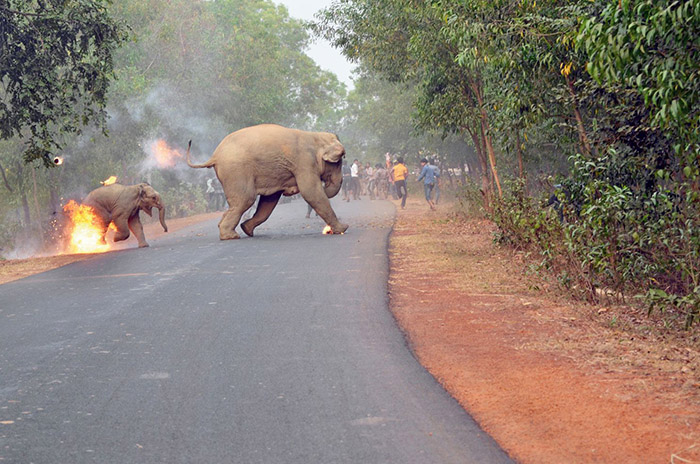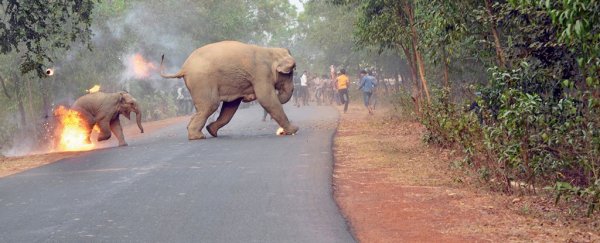The back legs of the baby elephant are consumed by fire as it chases after its startled mother, screaming.
In the chilling photo, a flaming ball of tar - the source of the fire, along with a few hurled firecrackers - is frozen in the air as a crowd sprints away from the petrified pachyderms.
Many things in the photo are unclear: the fate of the calf and its mother, the reason the men are attacking them on a road cut through a forest, whether the practice has a formal name or is just a random bit of sadism.
But in an instant, the image - titled "Hell Is Here" and snapped by Biplab Hazra - has shined a light on some of the darkest moments of the conflict between humans and elephants in India, whose lives increasingly overlap in what will soon be the world's most populous nation.
 "Hell Is Here" (Biplab Hazra/Sanctuary Wildlife Photography Awards)
"Hell Is Here" (Biplab Hazra/Sanctuary Wildlife Photography Awards)
In his entry to Sanctuary Wildlife's Photography awards, Hazra describes what happened when the mob met the large animals:
[The] calf screams in confusion and fear as the fire licks at her feet. Flaming tar balls and crackers fly through the air to a soundtrack of human laughter and shouts. In the Bankura district of West Bengal this sort of humiliation of pachyderms is routine, as it is in the other elephant-range states of Assam, Odisha, Chhattisgarh, Tamil Nadu and more.
Hazra's photo won the top prize at the Sanctuary awards, which drew 5,000 entries from across Asia. Eight photographers were awarded prizes.
Several of the winning photos highlight the compassion or cruelty or just downright oddity of human-animal interactions: villagers trying to save a trapped leopard from a well, a monkey peering out from a car's wheel well, a dead shark in a plastic crate on a crowded dock.
But the photo of the elephants hit a nerve with people across the world:
Look at the picture the mother elephant's foot is on fire & the baby is on fire quit defending the indefensible, heartbreaking how frightened they must be
— Big Cats (@big_catsf) November 8, 2017
People even jeered at Hazra for snapping a photo of the elephant torture instead of doing something to help.
More than 60 percent of the world's Asian elephants live in India as its human population balloons, spreading into migration routes and feeding grounds the animals have used for centuries.
EleAid, a conservation organisation, estimated that there may have once been more than a million elephants in India, before a human population explosion in the 20th century drastically reduced their numbers. Still, there are sustainable populations that are thriving alongside humans.
But it's far from a peaceful coexistence.
Last year, according to the Hindustan Times, as many as 29 people were killed by elephants in the Bankura District. The number was so high that the government began sending out text alerts whenever a high concentration of elephants was present.
Apart from killing people, the Times reported, the elephants that stray into West Bengal state routinely destroy property and damage crops.
In February 2016, a wild elephant rampaged through a town in east India, according to the Wall Street Journal, smashing cars and homes before being tranquilised and returned to the forest.
The elephant had wandered from the Baikunthapur forest, crossing roads and a small river before entering the town in search of food.
Hazra faulted the Indian government for not doing enough about human-pachyderm conflicts.
"The ignorance and bloodlust of mobs that attack herds for fun, is compounded by the plight of those that actually suffer damage to land, life and property by wandering elephants and the utter indifference of the central and state government to recognise the crisis that is at hand," Hazra wrote.
The nation was lauded for making India a stronghold for Asian elephants, Hazra said, but actions like the ones he photographed render that accomplishment moot.
"This achievement rings hollow as vital elephant habitats and routes continue to be ravaged, and human-elephant conflict escalates to a fatal degree," he wrote.
"For these smart, gentle, social animals who have roamed the sub-continent for centuries, hell is now and here."
2017 © The Washington Post
This article was originally published by The Washington Post.
